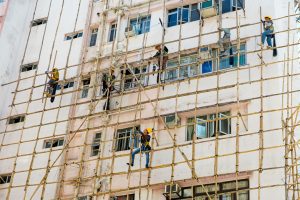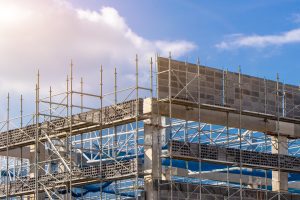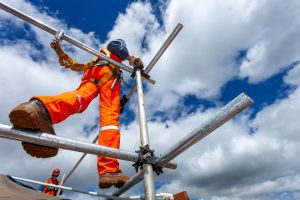Last Updated On 10th November 2025. Scaffolding accident claims can be made by anyone who suffered an injury on, under or near scaffolding. These include employees, the self-employed, contractors, and members of the public. However, negligence must have occurred. This means that whoever was responsible for the scaffolding must have breached health and safety regulations, directly causing your injury.
Settlements may include personal injury compensation for the physical pain and mental suffering as well as any financial losses associated with the injuries. To increase your chances of securing a settlement, you may want an experienced solicitor to work on your claim.
This is where Accident Claims can help you. If you speak to one of our advisors, they’ll provide you with a free consultation which will cover whether you are eligible to make a claim, if you are within the 3-year time limit to start one, advise on gathering evidence and provide an estimate of how much compensation you could claim.
If you are eligible and would like to pursue a scaffolding accident claim, you can be put in touch with one of our solicitors. Our solicitors use a No Win No Fee contract to provide their services.
Contact Us
Our aim with this guide is to answer any questions you might have and help you feel more familiar with the accident at work claims process. But if you’d rather talk to one of our expert advisors, you can get started by:
- Calling us on 0800 073 8801
- Using the live chat feature
- Contacting us online
4.8 (948 reviews)
Browse Our Guide
- What Are Scaffolding Accident Claims?
- Can You Claim For Scaffolding Accidents If You Don’t Work On The Premises?
- What Are Different Types Of Scaffolding Accidents?
- How Do You Claim For Scaffolding Accidents?
- What Is The Time Limit For Scaffolding Injury Claims?
- How Much Scaffolding Accident Compensation Could You Receive?
- Case Study: Successful Scaffolding Accident Claim
- What Are No Win No Fee Scaffolding Accident Claims?
- More Resources About Making A Personal Injury Claim
What Are Scaffolding Accident Claims?
Scaffolding accident claims are a kind of personal injury claim. But being injured on scaffolding isn’t enough in itself to make a claim; you need to be able to prove that negligence occurred.
Negligence, in personal injury terms, occurs when:
- You are owed a duty of care
- This duty of care is breached
- As a result, you are injured
When you’re working on a building site, you’re owed a duty of care. This could be owed by your employer, the site manager, or the main contractor, but could also come from any other companies working on the project. For example, if you are injured because another company set the scaffolding up wrong, then you would make your claim against this third party, not necessarily your employer.
This duty of care is outlined under Section 3 of the Health and Safety at Work etc. Act 1974 (HASAWA), with the steps needed to be taken in regard to scaffolding found in The Provision and Use of Work Equipment Regulations 1998.
This subject can seem complex, but our team is here to help. Contact us today to find out if you could make a scaffolding injury claim.
Can You Claim For Scaffolding Accidents If You Don’t Work On The Premises?
Scaffolding accidents don’t just affect workers; they can also affect members of the public. For example, if you were walking under some scaffolding that was covering a public pathway and it collapsed, this could cause serious injuries.
You’re still owed a duty of care as a private citizen under the Occupiers’ Liability Act 1957 (OLA), so if you can prove that the negligent actions of those responsible for the scaffolding led to your accident, you may be able to claim.
Keep reading to learn more about the different types of scaffolding accident claims. Or, contact our team today to get started on your claim.
What Are Different Types Of Scaffolding Accidents?
There are many ways that negligence can contribute to a scaffolding accident. For example, these might include:
Falls From Height
Falling from a height can have serious, and even fatal, consequences. If your employer asks you to work at a height on scaffolding and didn’t provide adequate Personal Protective Equipment (PPE), like a helmet or harness, this could cause you to fall and suffer various injuries, such as a back injury or head injury.
Falls from height can also happen if the scaffolding hasn’t been constructed properly, for example, if there is no safety barrier. You can take a look at the Work at Height Regulations 2005 for more information.
Scaffolding Collapse
If scaffolding isn’t erected or deconstructed properly, this can cause it to collapse.
Unsafe working practices when constructing scaffolding can include not properly following the manufacturer’s instructions, knowingly using broken or defective scaffold, and allowing employees who aren’t properly trained to construct it. If you were involved in a scaffolding collapse accident, you could suffer serious injuries, such as breaks and fractures.
Slips, Trips Or Falls On Scaffolding
Slips, trips, and falls are one of the most common reported accidents at work, but they can be especially dangerous on scaffolding.
This can happen in a number of ways; for example, if there has been a spillage of oil or water that was not signposted or cleaned up, this could cause you to slip on the wet surface.
Poor cable management for power tools could also cause you trip over a wire, causing you to fall from the scaffolding. These accidents could lead you to suffer an ankle or foot injury.
Lack Of Training
It’s your employer’s responsibility to provide any training you need to safely do your job, free of charge. If you weren’t giving training on how to safely work on or construct scaffolding, this could easily cause a scaffolding accident, and you could suffer from various types of injuries.
Contact our team today to learn more about scaffolding accidents, or read on to learn more about the claims process.

How Do You Claim For Scaffolding Accidents?
When you claim compensation for a scaffolding accident, you need to be able to prove that negligence occurred. This means you’ll need evidence that proves:
- Physical injuries.
- Mental injuries.
- Financial losses.
- Liability.
Some examples of evidence that could be used to claim for injuries caused by scaffold accidents include:
- Photographs of your injuries.
- Photographs of the scaffold, construction site, or other contributing factors.
- Accident report book logs.
- CCTV footage of the accident.
- Witness contact information so a statement can be collected from them.
- Medical records, scans, and X-rays.
- Bank statements and invoices that illustrate any financial losses.
One of the many benefits of working with a personal injury solicitor on your scaffolding accident compensation claim is that they can help you collect this evidence. For example, they can talk to witnesses, request CCTV footage, and arrange an independent medical assessment.
Read on to learn more about how to make scaffolding accident claims with a solicitor, or get in touch to get started.
What Is The Time Limit For Scaffolding Injury Claims?
In most cases, you have 3 years to start a scaffolding injury claim. This is the general personal injury claim time limit set out in the Limitation Act 1980 and it starts from the day of your accident.
However, the Limitation Act allows for exceptions when the claimant cannot manage the claim for themselves. These include:
- Minors under the age of 18 who have a pause applied to the limitation period, so the time limit only starts running from their 18th birthday.
- Those without the mental capacity to manage the claims process. There’s an indefinite hold on the time limit for these claimants. However, if they recover this capacity, then the time limit runs from that date.
In either of these cases, a litigation friend can be appointed by the courts to manage the claim on behalf of the injured party while the time limit is paused. Any suitable adult can apply to be a litigation friend as long as they act in the claimant’s best interest.
To check if you are still within the time limit to start a scaffolding injury claim or to discuss applying to become a litigation friend, speak to one of our advisors today.

How Much Scaffolding Accident Compensation Could You Receive?
So, how much compensation could you get for a successful scaffolding accident claim? The answer to this question depends on the unique circumstances surrounding your claim.
Compensation in personal injury claims is awarded on a case-by-case basis, and can contain two heads: general and special damages. General damages are awarded in every successful claim, and they cover the pain, suffering, and loss of amenity caused by your injuries.
The Judicial College Guidelines (JCG) is one tool that professionals use when valuing your claim. This document offers guideline compensation brackets for different kinds of injuries, including injuries that could be caused by scaffolding accidents.
You can take a look at some of these examples in the table below, but please keep in mind that the first entry isn’t from the JCG, and that these amounts aren’t fixed.
| Injury | Compensation | Notes |
|---|---|---|
| Multiple Severe Injuries + Special Damages | Up to £1,000,000+ | Multiple severe injuries and financial expenses which might include lost earnings and the cost of mobility aids. |
| Very Severe Brain Damage (a) | £344,150 to £493,000 | There is little to no response to surroundings, and a need for full-time care. |
| Moderate Brain Damage (c) (ii) | £110,720 to £183,190 | There is a risk of epilepsy, and a modest to moderate intellectual change. |
| Severe Back Injuries (a) (i) | £111,150 to £196,450 | The most severe cases of damage to the nerve roots and spinal cord. |
| Severe Back Injuries (a) (ii) | £90,510 to £107,910 | Cases in this bracket will have exceptional features that bring them out of lower brackets, such as nerve root damage. |
| Severe Neck Injuries (a) (i) | In the region of £181,020 | Incomplete paraplegia or permanent spastic quadriparesis. |
| Severe Injuries To The Hips And Pelvis (a) (i) | £95,680 to £159,770 | Extensive pelvis fractures with other features, like dislocation of the back and a ruptured bladder. |
| Chest Injuries (c) | £38,210 to £66,920 | Continuing disability caused by damage to the lungs and chest. |
| Less Serious Leg Injuries (c) (i) | £21,920 to £33,880 | Fractures resulting in an incomplete recovery. |
Special damages aren’t awarded in every claim, because they address the financial losses caused by your injuries.
Scaffolding accidents can result in a range of injuries, from relatively minor to life-changing, and can cause immense financial loss. Under special damages, you could claim back the cost of:
- Childcare
- Present and future lost earnings
- Mobility aids
- Home adjustments, like having doorways widened for a wheelchair
- Professional care
- Private healthcare and prescriptions
- Help with cooking or cleaning
- Travel
Get in touch with our team today to start your free initial consultation and find out if you could claim accident at work compensation.
4.8 (948 reviews)
Case Study: Successful Scaffolding Accident Claim
In this example case study*, we look at how Mr M made a successful scaffolding accident claim with the help of a No Win No Fee solicitor specialising in accident at work claims.
Mr M was required to climb scaffolding as part of his job duties on a construction site. However, because it had not been inspected as per the Work at Height Regulations 2005, he did not realise it was not secure. As a result, Mr M suffered minor brain damage and multiple fractures in a fall.
Mr M contacted a No Win No Fee solicitor who helped him gather evidence. Because Mr M noted his colleague’s contact information, the solicitor was able to take witness statements from them that further strengthened his case. His employer accepted liability for his injuries.
Mr M was awarded a settlement of £352,200. This included general damages for various fractures to his back, pelvis, an arm and a leg at £113,000. The rest of his settlement included £239,200 for special damages. This covered his lost wages and pension contributions, domestic support while he recovered, rehabilitation and nursing care, as well as costs for retraining in a new job role.
To find out how a No Win No Fee solicitor can help you secure a settlement, speak to one of our advisors now.
What Are No Win No Fee Scaffolding Accident Claims?
We always recommend seeking legal help from a solicitor when you want to claim compensation. This is because a solicitor can help you gather evidence, decode technical legal terms, and make sure that your claim is filed within the time limit.
But what is a No Win No Fee agreement, and how can it help? Our solicitors work under the terms of a Conditional Fee Agreement (CFA), which means they work on a No Win No Fee basis.
When a solicitor works like this, it means they:
- Don’t take payment to start work on the claim.
- Don’t take payment for their work as the claim is ongoing.
- Don’t take payment for their services if the claim fails.
If it succeeds, a success fee will be deducted from your compensation.The law limits the percentage that can be taken as this success fee.
Contact Us
If you’re ready to find out how our solicitors could help you, get in touch today. Our advisors can provide a free consultation, during which they’ll answer any questions you have about the scaffolding accident claims process and evaluate the validity of your claim. Then, they can connect you with one of our expert solicitors.
Get started today by:
- Calling us on 0800 073 8801
- Using the live chat feature
- Contacting us online
More Resources About Making A Personal Injury Claim
For more helpful personal injury claims:
- Learn how to claim if you slipped on the stairs at work.
- Find out how to claim if hit by heavy boxes at work.
- Get help with claiming after being injured on a roof.
Alternatively, to find further resources:
- Find out when to call 999 from the NHS.
- Advice on construction work from the Health and Safety Executive (HSE).
- Workplace research and statistics from the Government.

*Please take note that the case study was only included for illustrative purposes.
Thank you for reading our guide on scaffolding accident claims. If you have any further questions or would like to discuss your case, you can contact one of our advisors.





